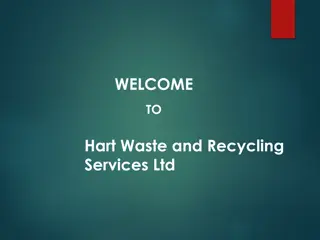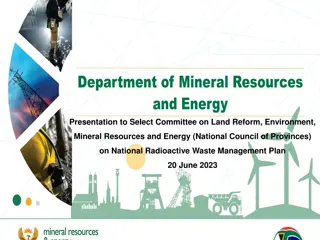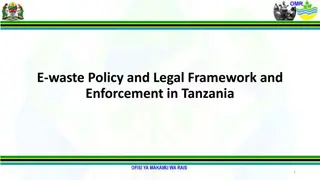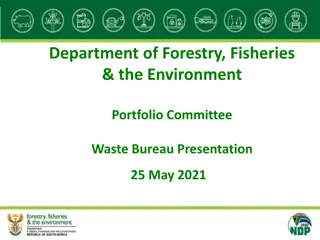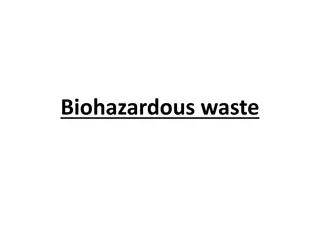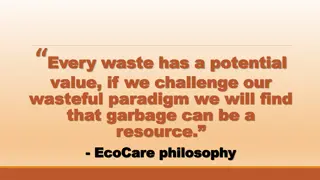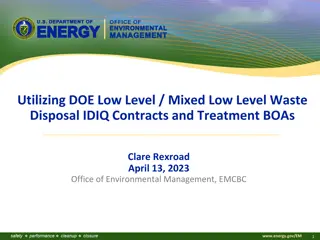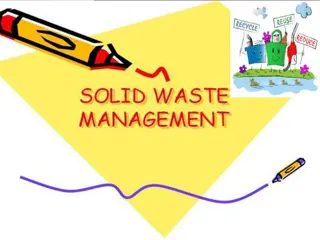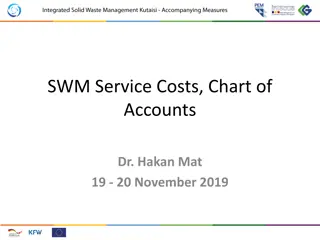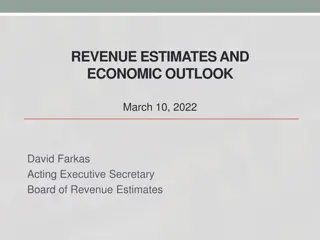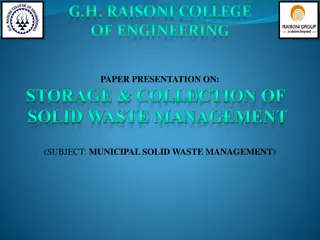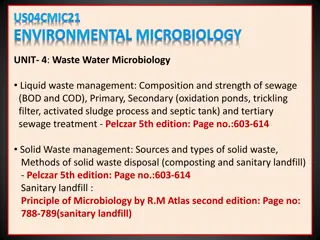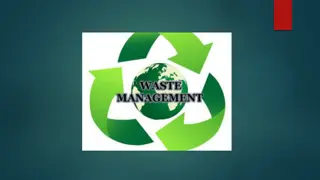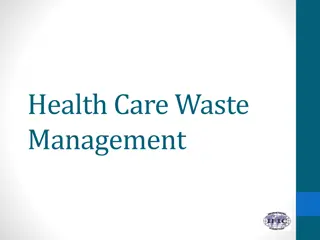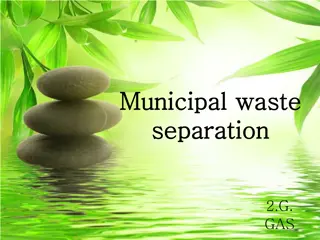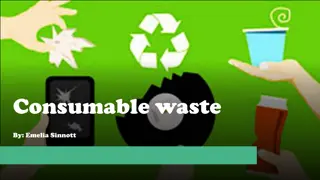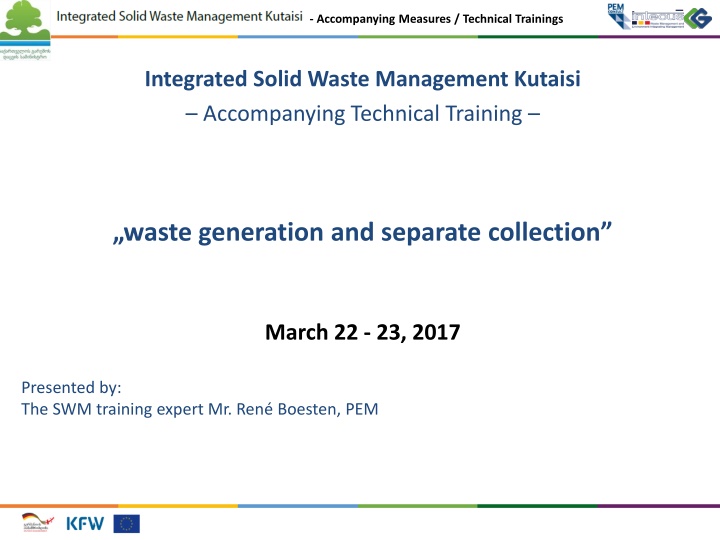
Solid Waste Management Technical Training Kutaisi Estimation and Forecasting
Explore detailed technical training sessions on estimating and forecasting waste generation in Kutaisi, including creating parameters for different activities, long-term population forecasts, and waste calculation examples. Gain insights into managing solid waste effectively. Presented by SWM expert Mr. Ren Boesten.
Download Presentation

Please find below an Image/Link to download the presentation.
The content on the website is provided AS IS for your information and personal use only. It may not be sold, licensed, or shared on other websites without obtaining consent from the author. If you encounter any issues during the download, it is possible that the publisher has removed the file from their server.
You are allowed to download the files provided on this website for personal or commercial use, subject to the condition that they are used lawfully. All files are the property of their respective owners.
The content on the website is provided AS IS for your information and personal use only. It may not be sold, licensed, or shared on other websites without obtaining consent from the author.
E N D
Presentation Transcript
- Accompanying Measures / Technical Trainings Integrated Solid Waste Management Kutaisi Accompanying Technical Training waste generation and separate collection March 22 - 23, 2017 Presented by: The SWM training expert Mr. Ren Boesten, PEM
- Accompanying Measures / Technical Trainings Estimation of Generated Waste Amounts 1.a) commercial activities by the use of specific parameters 1. Creation of specific parameters for inhabitants public services (hospitals, schools, kindergartens) commercial activities (offices, restaurants, cinemas, department stores, supermarkets, a.o.) 2. Calculation of the waste amounts according to the real figures of the inhabitants or specific activities in the municipality Calculation on the basis of the number of inhabitants or
- Accompanying Measures / Technical Trainings Estimation of Generated Waste Amounts Creation of specific parameters for Inhabitants Waste per day per person Waste per year per person FS Kutaisi Regional capital Urban > 10,000 Urban < 10,000 Rural 0.85 0.70 0.55 0.40 310 256 201 146 Waste per day per person Waste per year per person Real data 2015 Waste delivered at the landfill (ton) 54,000 Population 2015 Collection efficiency total waste Kutaisi city 147,635 90% 48,600 0.90 330
- Accompanying Measures / Technical Trainings Estimation of Generated Waste Amounts Long term forecast: Inhabitants Total population from Georgian statistics office Population forecast: Pop growth rates Rural Urban per year -0.5% 2.0% Economic growth: 1% growth = 0.3% more waste Tourism waste: 1 overnight stay = waste/day from resident
- Accompanying Measures / Technical Trainings Estimation of Generated Waste Amounts 1.a) Calculation on the basis of the number of inhabitants or commercial activities by the use of specific parameters Example from Bulgaria: kg/m3 Object Accumulation norm Yearly l 700 - 400 330 235 90 120 90 250 - - 460 150 250 70 36 Daily kg 230 - 80 100 70 20 26 20 50 - - 120 30 100 35 18 kg 0,63 0,1 0,22 0,28 0,19 0,06 0,09 0,06 0,14 0,06 0,03 0,33 0,08 0,27 0,09 0,06 l 1. 2. 3. 4. 5. 6. 7. 8. 9. 10. 11. 12. 13. 14. 15. 16. Hospital 1 bed Policlinics 1 person Hotels - 1 person Dormitory 1 person Kinder-garden 1 bed School 1 pupil Institute 1 pupil Cinemas 1 seat Offices 1 person Restaurant 1 meal Kitchenette 1 meal Department store for food 1 m2 Department store for industrial goods 1 m2 Tailor office 1 person Warehouses 1 m2 Markets 1 m2 1,9 0,4 1,1 0,93 0,78 0,3 0,4 0,3 0,7 0,2 0,1 1,27 0,4 0,68 0,19 0,12 330 250 200 300 300 320 220 220 200 300 300 260 200 400 500 500
- Accompanying Measures / Technical Trainings Estimation of Generated Waste Amounts Long term forecast: Waste from inhabitants Waste from tourists Waste from public services (hospitals, schools, kindergartens) Waste from streetcleaning and markets Waste from commercial activities (offices, restaurants, cinemas, department stores, supermarkets, etc.)
- Accompanying Measures / Technical Trainings Estimation of Generated Waste Amounts Long term forecast and waste disposal costs: Waste from: inhabitants tourists => paid via waste service fee => paid via contracts with hotels and service fee => paid via contracts or service fee public services streetcleaning and markets => paid via waste service fee commercial activities => paid via contracts or service fee
- Accompanying Measures / Technical Trainings Analysis of Waste Composition How to get figures on Waste Composition?
- Accompanying Measures / Technical Trainings Analysis of Waste Composition What it is good for? to know material composition (recyclable components, harmful components) to assess/be aware of treatment/safety needs to understand where prevention should/can be exercised to assess feasibility and efficient ways of separate collection to determine other management measures and monitor effectiveness to get note on changes/trends in the waste generation to support waste estimations and/or verify available data to educate people
- Accompanying Measures / Technical Trainings Waste prognosis meaning and importance What it is good for? to know future waste amounts generated to plan waste collection and waste treatment capacities to understand the effects of waste management measures to assess feasibility and efficient ways of separate collection to get note on changes/trends in the waste generation to educate people
- Accompanying Measures / Technical Trainings Waste calculation Total waste = Waste per capita * total population + non- household waste + tourism waste Total waste = Waste delivered at the landfill
- Accompanying Measures / Technical Trainings Waste delivered at the landfills (ton) 1,949 2,423 845 54,442 6,664 8,396 2,269 2,227 4,836 7,105 1,331 2,716 Waste calculated (tons) 2,481 6,058 2,239 51,731 7,514 11,326 4,089 3,519 9,639 9,019 2,818 3,743 Baghdati Municipality Chiatura Municipality Kharagauli Municipality Kutaisi Municipality Sachkhere Municipality Samtredia Municipality Terjola Municipality Tkibuli Municipality Tskaltubo Municipality Zestaponi Municipality Vani Municipality Khoni Municipality More non-household waste?
- Accompanying Measures / Technical Trainings Waste delivered at the landfills (ton) 1410.15 Waste calculated (tons) C. Ambrolauri Ambrolauri Municipality Oni Tsageri 305 1,361 652 912 1185.1 1079.4 What happens with the Lentekhi ?? 1,194 waste?
- Accompanying Measures / Technical Trainings Waste prognosis meaning and importance Approaching the subject of separate collection must be addressed in quality and quantity in your WM plan (2019 deadline!) due to 2019 deadline a matter of prognosis Source: Boer et al. (2005): Waste Management Planning and Optimization
- Accompanying Measures / Technical Trainings Impact of separate collection Waste composition: Minimum (%) Maximum (%) Waste categories Paper and cardboard Glass bottles Scrap metal Polyethylene / Plastics Sanitary paper/diapers Textiles Organic Construction waste Hazardous waste Leather/rubber Other Loss (humidity) 12.2 4.8 1.5 13.6 4.8 5.4 38.6 4.0 1.4 16.7 6.4 2.3 17.5 8.3 5.9 42.7 4.1 1.7 household 1.7 1.4 0.3 2.7 2.1 1.5
- Accompanying Measures / Technical Trainings Impact of separate collection Estimated amounts of recyclables in municipal waste Paper (t/a) Glass (t/a) Plastics (t/a) lower limit Estimated amounts of recyclables in municipal waste lower limit upper limit lower limit upper limit upper limit Imereti Racha-Lechkhumi 12,447 20,596 569 4,852 222 7,837 13,885 21,603 408 635 1,073 1,126
- Accompanying Measures / Technical Trainings Impact of separate collection Targets for collection 2020 Paper 30% Glass 20% Plastic 30% 2025 50% 50% 50% 2030 80% 80% 80% waste composition paper glass plastics bio 12.2% 4.8% 13.6% 38.6% 16.7% 6.4% 17.5% 42.7%
- Accompanying Measures / Technical Trainings Impact of separate collection Waste calculated (tons) 2020 2,266 5,662 2,035 49,033 7,044 10,664 3,792 3,251 9,062 8,473 2,585 3,464 2025 2,102 5,131 1,896 43,816 6,364 9,593 3,463 2,981 8,164 7,639 2,387 3,171 2030difference 1,874 4,575 1,691 39,067 5,674 8,553 3,088 2,658 7,279 6,811 2,128 2,827 Baghdati Municipality Chiatura Municipality Kharagauli Municipality Kutaisi Municipality Sachkhere Municipality Samtredia Municipality Terjola Municipality Tkibuli Municipality Tskaltubo Municipality Zestaponi Municipality Vani Municipality Khoni Municipality 2,481 6,058 2,239 51,731 7,514 11,326 4,089 3,519 9,639 9,019 2,818 3,743 -25%
- Accompanying Measures / Technical Trainings Impact of separate collection Waste calculated (tons) 2020 2025 2030difference 305 199 258 230 C. Ambrolauri Ambrolauri Municipality Oni Tsageri Lentekhi 1,3611,202 1,1531,028 652 529 912 775 1,1941,043 1,012 902 553 493 772 689 -25%
- Accompanying Measures / Technical Trainings Impact of separate collection Biowaste Kitchen, gardens, parks Composition: urban: 35 - 40% Rural: 45 60% Collection / prevention Urban: 30 - 40% (mainly collection) Rural: 50 60% (mainly prevention)

